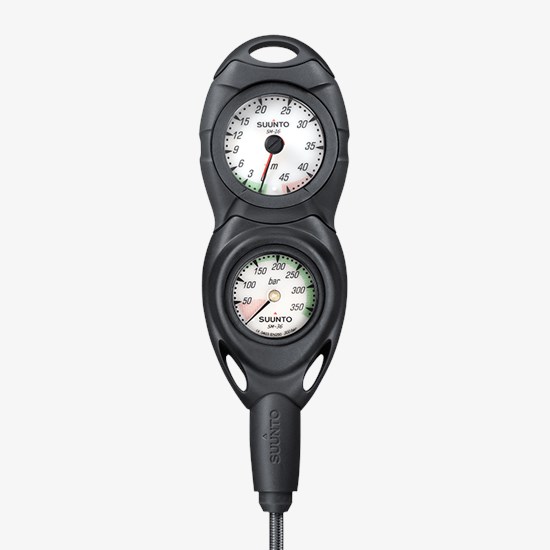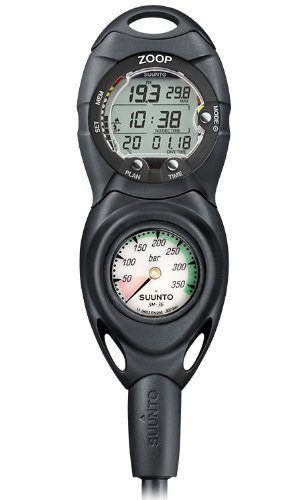
Updated August 11, 2022
Durable, accurate gauges are essential for a scuba diver. The SPG (submersible pressure gauge) indicates how much air is left in the tank and the depth gauge shows what depth you are at. These days many divers use a dive computer that provides digital depth information, but still use an analog gauge as a backup in the case of battery problems or other computer malfunction. Others go with the analog gauge only. Today you can still get your SPG and depth gauge combined into a handy console mounted at the end of the high-pressure hose. Some even add a compass to the console, as well.
Here I’ll show you the important factors to consider in the selection of the best combo of gauges to suit your needs. Then I’ll introduce you to ten of the best models on the market this year, outline the main features and pros and cons, and provide a comparison in the form of a table.
If you have any questions or concerns, please use the comments section at the bottom. I’d love to hear your thoughts.
Best Scuba Diving Gauges List
- Suunto Analog Double Gauge
- Oceanic Oil Filled Combo
- ScubaPro Depth and Pressure Gauge
- Tusa 2 Gauge SCA-280
- Cressi Mini 2
- Sherwood Compact Console
- Mares Mission 2
- Aqua Lung 2 Gauge Console
- Oceanic Max Depth SWIV Combo
- Suunto Zoop Scuba Diving Computer
Buying Guide – How to Choose the Best Scuba Gauges
Unit – Gauges will come in imperial or metric units based on where you are. Locations influenced by the United States will tend to use imperial. I suggest you know both systems well enough to know how to do a quick calculation and know how deep you are and how much air you have left. In selecting your own gear, go with the one you are most comfortable with.
Weight and Size – There are differences in size and weight between models. A smaller person may feel less burdened by smaller and lighter gauges. For travel purposes, the lighter the load the easier it is to transport and the cheaper the fees in air travel.
Temperature Indicator – It is good to know what the water temperature is for future dive planning. Perhaps there are changes or a thermocline that would be useful to calibrate.
Maximum Depth Needle – In an analog gauge the depth need pushes another needle to the point of the maximum depth and that needle stays in position as a reference. This is helpful for dive planning and for multi-level dives without a computer.
Color Coding and Luminescent Dials – Luminescent dials are visible in the dark allowing better visibility of your gauges. Color coding makes key levels more evident such as lower air and deeper depths. The more obvious the better for divers who are fatigued or under the influence of nitrogen narcosis.
Eyelets on the gauge housing or rubber boot are handy to allow attachment to your person or BCD with a clip or lanyard. This enables the diver to keep the gauges in position to use and under control so as not to damage them or the wildlife that a dangling console could slam into.
Best Scuba Diving Gauges
- Unit of measure: imperial
- Weight: .75 pounds
- Maximum depth: 230 feet
- Rating: 4.7
- Price: $$$$$
Pros: easy to read luminous dials, lightweight, durable impact-resistant console
Cons: a little expensive, no temperature indicator
- Unit of measure: imperial
- Weight: 1.1 pounds
- Maximum depth: 150 feet
- Rating: 4.6
- Price: $$
Pros: oil-filled gauge holds form under pressure, durable design with nylon reinforced body, temperature indicator, fluorescent markings
Cons: no maximum depth needle, a bit bulky
ScubaPro Depth and Pressure Gauge
- Unit of measure: imperial or metric
- Weight: 1 pound
- Maximum depth: 150 feet/45 meters
- Rating: 4.7
- Price: $$$
Pros: durable brass construction, large, easy to read dials, lightweight, lanyard attachment
Cons: no temperature indicator
- Unit of measure: imperial
- Weight: 1.25 pounds
- Maximum depth: 200 feet
- Rating: 4.9
- Price: $$
Pros: luminescent easy to read dial, temperature indicator, eyelets for clips
Cons😕
- Unit of measure: imperial or metric available
- Weight: .9 pounds
- Maximum depth: 230 feet/70 meters
- Rating: 4.7
- Price: $
Pros: easy to read color coding on the two gauges, shock and scratch-resistant, lightweight, temperature indicator
Cons: two attachment loops are a little small and difficult to manipulate during the dive
- Unit of measure: metric
- Weight: .65 pounds
- Maximum depth: 150 feet
- Rating: 4.5
- Price: $$
Pros: compact and low profile, lightweight, color-coded with low air and greater depths in red, temperature indicator
Cons: ?
- Unit of measure: metric
- Weight: 1.4 pounds
- Maximum depth: 70 meters
- Rating: 4.7
- Price: $
Pros: fluorescent easy to read dial in the dark, shock resistant case, color-coded for low air
Cons: a little heavy, no temperature indicator
- Unit of measure: imperial
- Weight: .75 pounds
- Maximum depth: 200
- Rating: 4.8
- Price: $$$
Pros: luminescent easy to read dial, lightweight, writing slate on the back of the console, with an update a compass can be mounted in place of the slate, temperature indicator
Cons: ?
- Unit of measure: imperial
- Weight: 1.2 pounds
- Maximum depth: 200 feet
- Rating: 4.9
- Price: $$$
Pros: Nitrox compatible to 50%, luminescent easy to read dial, shock resistant, temperature indicator
Cons: a little heavy
Suunto Zoop Scuba Diving Computer
- Unit of measure: metric
- Weight: .75 pounds
- Maximum depth: 100 meters
- Rating: 5
- Price: $$$$
Pros: Nitrox compatible to 50%, dive computer serves as a digital depth gauge, easy navigation, stores 50 hours of dive data, data is downloadable to your PC, analog SPG (submersible pressure gauge), impact-resistant, temperature indicator
Cons: slightly more expensive
For more information on the Suunto Zoop, an introduction to dive computers, and a buying guide, please check out my post:
Best Scuba Gauge Comparison Table
Feedback and Comments
I hope you found this post on scuba gauges interesting and useful. If you have any questions or ideas, please feel free to share them in the comments section. If there is no comments section directly below, click here: >>comments<<


















